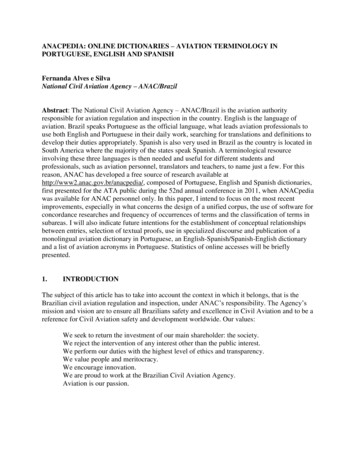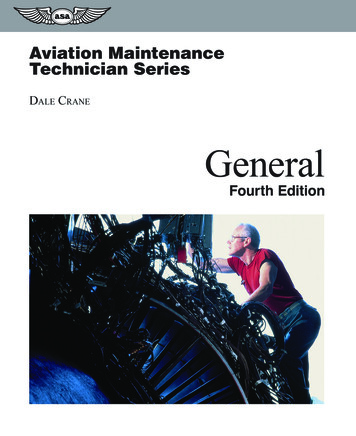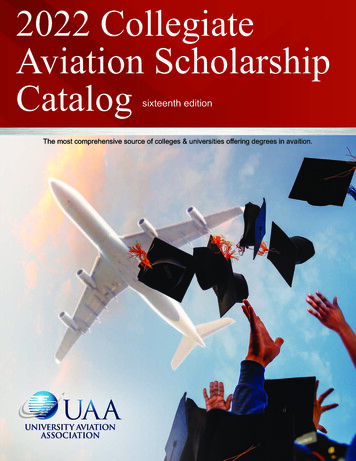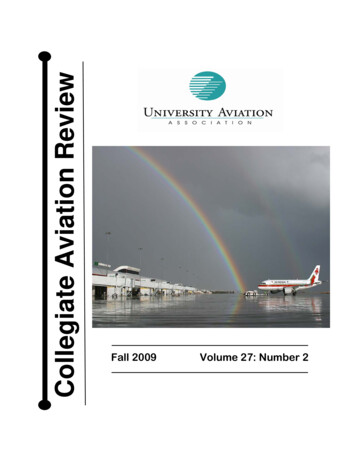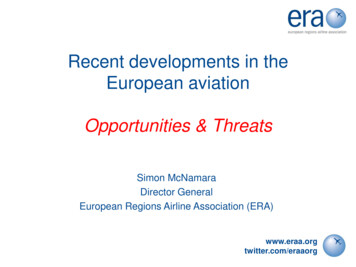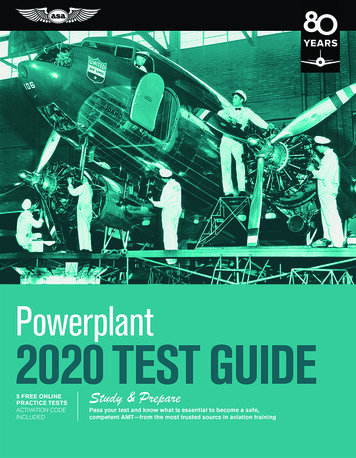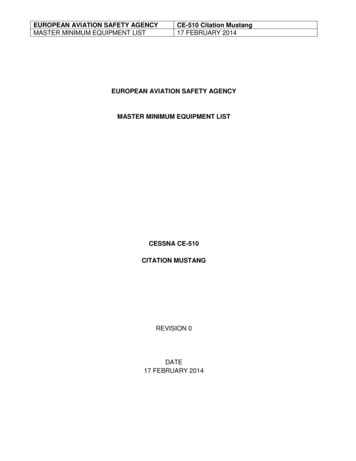
Transcription
EUROPEAN AVIATION SAFETY AGENCYMASTER MINIMUM EQUIPMENT LISTCE-510 Citation Mustang17 FEBRUARY 2014EUROPEAN AVIATION SAFETY AGENCYMASTER MINIMUM EQUIPMENT LISTCESSNA CE-510CITATION MUSTANGREVISION 0DATE17 FEBRUARY 2014
EUROPEAN AVIATION SAFETY AGENCYMASTER MINIMUM EQUIPMENT LISTCE-510 Citation Mustang17 FEBRUARY 2014INTENTIONALLY LEFT BLANK
EUROPEAN AVIATION SAFETY AGENCYLMASTER MINIMUM EQUIPMENT LISTCE-Sb Citation Mustang17 FEBRUARY 2014European Aviation Safety AgencyMASTER MINIMUM EQUIPMENT LISTCE-510REVISION: 0This Master Minimum Equipment List (MMEL) is approved by the European AviationSafety Agency (EASA) at the hereafter revision under the type certificate (EASA TC A.502)as part of the Operational Suitability Data (OSD) as per Regulation (EU) 748/2012 asamended by Regulation (EU) No 69/2014.François FABREDeputy Head of Department FlightExpert Department Certification Directoratefor and on behalf of EASA—-Date: 17 February 2014Correspondence concerning this document should be addressed to the office listed below:Cessna Aircraft CompanyP.O. Box 7704Wichita, KS 67277-7704United StatesEuropean Aviation Safety AgencyPosifach 10 125350452 KoInGermanyAttention:Dept 380Engineering Flight TestMMEL GroupAttention:EASA MMEL Project ManagerExperts DepartmentCertification Directorate
EUROPEAN AVIATION SAFETY AGENCYMASTER MINIMUM EQUIPMENT LISTCE-510 Citation Mustang17 FEBRUARY 2014INTENTIONALLY LEFT BLANK
EUROPEAN AVIATION SAFETY AGENCYMASTER MINIMUM EQUIPMENT LISTCE-510 Citation Mustang17 FEBRUARY 2014REVISION RECORDREVISION No.ISSUE DATEORIGINAL17 FEBRUARY 2014INCORPORATED BYDATE
EUROPEAN AVIATION SAFETY AGENCYMASTER MINIMUM EQUIPMENT LISTCE-510 Citation Mustang17 FEBRUARY 2014INTENTIONALLY LEFT BLANK
EUROPEAN AVIATION SAFETY AGENCYMASTER MINIMUM EQUIPMENT LISTCE-510 Citation Mustang17 FEBRUARY 2014TABLE OF 384546527376APPROVAL SHEETREVISION RECORDTABLE OF CONTENTSLIST OF EFFECTIVE PAGESPREAMBLEDEFINITIONS AND EXPLANATORY NOTESHILIGHTS OF REVISIONAIR CONDITIONINGAUTO FLIGHTCOMMUNICATIONSELECTRICAL POWEREQUIPMENT/FURNISHINGSFIRE PROTECTIONFLIGHT CONTROLSFUELICE AND RAIN PROTECTIONINDICATING & RECORDLANDING GEARLIGHTSNAVIGATIONWATER/WASTECENTRAL MAINTENANCE SYSTEMINFORMATION SYSTEMSDOORSENGINE FUEL & CONTROLENGINE CONTROLS
EUROPEAN AVIATION SAFETY AGENCYMASTER MINIMUM EQUIPMENT LISTCE-510 Citation Mustang17 FEBRUARY 2014INTENTIONALLY LEFT BLANK
EUROPEAN AVIATION SAFETY AGENCYMASTER MINIMUM EQUIPMENT LISTCE-510 Citation Mustang17 FEBRUARY 2014LIST OF EFFECTED 230-130-231-131-2TitleRevisionDateApproval SheetRevision RecordTable of ContentsList of Effective PagesList of Effective Pages (Continued)PreamblePreamble (Continued)Definitions and Explanatory NotesDefinitions and Explanatory Notes (Continued)Definitions and Explanatory Notes (Continued)Definitions and Explanatory Notes (Continued)Definitions and Explanatory Notes (Continued)Highlights of RevisionAir OriginalOriginalOriginalAir Conditioning (Continued)Air Conditioning (Continued)Air Conditioning (Continued)Auto FlightAuto Flight (Continued)CommunicationsCommunications (Continued)Communications (Continued)Communications (Continued)Electrical PowerElectrical Power (Continued)Equipment / FurnishingsEquipment / Furnishings (Continued)Equipment / Furnishings (Continued)Equipment / Furnishings (Continued)Equipment / Furnishings (Continued)Equipment / Furnishings (Continued)Fire ProtectionFire Protection (Continued)Flight ControlsFlight Controls (Continued)FuelFuel (Continued)Ice and Rain ProtectionIce and Rain Protection (Continued)Indicating / Recording SystemsIndicating / Recording Systems nalOriginalOriginalOriginal17 Feb 201417 Feb 201417 Feb 201417 Feb 201417 Feb 201417 Feb 201417 Feb 201417 Feb 201417 Feb 201417 Feb 201417 Feb 201417 Feb 201417 Feb 201417 Feb 201417 Feb 201417 Feb 201417 Feb 201417 Feb 201417 Feb 201417 Feb 201417 Feb 201417 Feb 201417 Feb 201417 Feb 201417 Feb 201417 Feb 201417 Feb 201417 Feb 201417 Feb 201417 Feb 201417 Feb 201417 Feb 201417 Feb 201417 Feb 201417 Feb 201417 Feb 201417 Feb 201417 Feb 201417 Feb 201417 Feb 201417 Feb 2014
EUROPEAN AVIATION SAFETY AGENCYMASTER MINIMUM EQUIPMENT LISTCE-510 Citation Mustang17 FEBRUARY 2014LIST OF EFFECTED 46-146-252-152-273-173-276-1TitleLanding GearLanding Gear (Continued)LightsLights (Continued)Lights (Continued)Lights (Continued)NavigationNavigation (Continued)Navigation (Continued)Navigation (Continued)Navigation (Continued)Navigation (Continued)Navigation (Continued)Navigation (Continued)OxygenOxygen (Continued)Water / WasteWater / Waste (Continued)Central Maintenance SystemCentral Maintenance System (Continued)Information SystemsInformation Systems (Continued)DoorsDoors (Continued)Engine Fuel and ControlEngine Fuel and Control (Continued)Engine inalOriginalOriginalOriginalOriginal17 Feb 201417 Feb 201417 Feb 201417 Feb 201417 Feb 201417 Feb 201417 Feb 201417 Feb 201417 Feb 201417 Feb 201417 Feb 201417 Feb 201417 Feb 201417 Feb 201417 Feb 201417 Feb 201417 Feb 201417 Feb 201417 Feb 201417 Feb 201417 Feb 201417 Feb 201417 Feb 201417 Feb 201417 Feb 201417 Feb 201417 Feb 2014
EUROPEAN AVIATION SAFETY AGENCYMASTER MINIMUM EQUIPMENT LISTCE-510 Citation Mustang17 FEBRUARY 2014PREAMBLEThe following is applicable for operators under European air operations regulations (Regulation AirOperations). Paragraph 1.c.2 of Annex I to Article 5 (essential requirements for airworthiness) ofRegulation (EC) No 216/2008 (the ‘Basic Regulation’) requires that all equipment installed on anaircraft required for type certification or by operating rules shall be operative. However, paragraph2.a.3 of Annex IV to Article 8 (essential requirements for air operations) of the Basic Regulationalso allows the use of a Minimum Equipment List (MEL) where compliance with certain equipmentrequirements is not necessary in the interests of safety under all operating conditions. Experiencehas shown that with the various levels of redundancy designed into aircraft, operation of everysystem or installed component may not be necessary when the remaining operative equipment canprovide an acceptable level of safety.EASA Master Minimum Equipment List (MMEL) is developed by the Type Certificate Holder toimprove aircraft utilisation and thereby provide more convenient and economic air transportationfor the public. EASA MMEL includes those items of equipment related to airworthiness, airoperations, airspace requirements and other items of equipment which EASA finds may beinoperative and yet maintain an acceptable level of safety by appropriate conditions and limitations;it does not contain obviously required items such as wings, flaps, and rudders.The MMEL is the basis for development of individual operator's MELs, which take intoconsideration the operator's particular aircraft equipment configuration and operational conditions.An operator's MEL may differ in format from the MMEL, but cannot be less restrictive than theMMEL. The individual operator's MEL, when approved permits operation of the aircraft withinoperative equipment.Equipment not required by the operation being conducted and equipment in excess of therequirements are included in the MEL with appropriate conditions and limitations. The MEL mustnot deviate from Airworthiness Directives or any other Mandatory Requirement It is important toremember that all equipment related to the airworthiness and the operating requirements of theaircraft not listed on the MMEL must be operative.Suitable conditions and limitations in the form of placards, maintenance procedures, crewoperating procedures and other restrictions as necessary are specified in the MEL to ensure thatan acceptable level of safety is maintained.
EUROPEAN AVIATION SAFETY AGENCYMASTER MINIMUM EQUIPMENT LISTCE-510 Citation Mustang17 FEBRUARY 2014PREAMBLE(Continued)The MEL is intended to permit operation with inoperative items of equipment for a period of timeuntil rectifications can be accomplished. It is important that rectifications be accomplished at theearliest opportunity. In order to maintain an acceptable level of safety and reliability, the MMELestablishes limitations on the duration of, and conditions for operation with, inoperative equipment.The operator may be permitted, by their competent authority, a one-time extension of theapplicable rectification intervals B, C or D for the same duration as that specified in their MEL. Thisextension policy has been taken into account during the development of this document.When an item of equipment is discovered to be inoperative, it is reported by making an entry in theAeroplane Maintenance Record/Logbook as prescribed by the applicable regulations. The item isthen either rectified or may be deferred per the MEL or other approval means acceptable to thecompetent Authority prior to further operation. MEL conditions and limitations do not relieve theoperator from determining that the aeroplane is in a condition for safe operation with items ofequipment inoperative.When these requirements are met, an Airworthiness Release, Aeroplane MaintenanceRecord/Logbook entry, or other approved documentation is issued as prescribed by the applicableregulations. Such documentation is required prior to operation with any item of equipmentinoperative.Operators are responsible for exercising the necessary operational control to ensure that anacceptable level of safety is maintained. The exposure to additional failures during continuedoperation with inoperative systems or components must also be considered. Wherever possibleaccount has been taken in this MMEL of multiple inoperative items. However, it is unlikely that allpossible combinations of this nature have been accounted for. Therefore, when operating withmultiple inoperative items, the inter-relationships between those items and the effect on aeroplaneoperation and crew workload must be considered.Operators are to establish a controlled and sound rectification program including the parts,personnel, facilities, procedures and schedules to ensure timely rectification. This program shouldidentify the actions required for Maintenance discrepancy messages.WHEN USING THE MEL, COMPLIANCE WITH THE STATED INTENT OF THE PREAMBLE,DEFINITIONS AND THE CONDITIONS AND LIMITATIONS SPECIFIED IN THE MEL ISREQUIRED.
EUROPEAN AVIATION SAFETY AGENCYMASTER MINIMUM EQUIPMENT LISTCE-510 Citation Mustang17 FEBRUARY 2014DEFINITIONS AND EXPLANATORY NOTES1.In this list, the items of equipment are classified in systems according to the ATA 100specification. Individual items within a given ATA classification are numbered sequentially.2.“Item” (Column 1): The equipment, system, components or function as listed in Column 1.“(If installed)”: Indicates the listed item of equipment is not applicable to all models orconfigurations. It does not imply that the aeroplane may be operated in accordance with thisMMEL with the item removed.NOTE 1:Items annotated in UPPER CASE letters indicate the precise flight decklegend used.3.“Rectification Intervals” (Column 2): Inoperative items or components, deferred inaccordance with the MEL, must be rectified at or prior to the rectification intervalsestablished by the following letter designators given in the “Rectification Interval” column (2)of the MMEL.Category ANo standard interval is specified. However, items in this category shall be rectified inaccordance with the conditions stated in the Remarks column (5) of the MMEL.Where a time period is specified it shall start at 00:01 on the calendar day following the dayof discovery.Category BItems in this category shall be rectified within three (3) consecutive calendar days,excluding the day of discovery. For example, if it was recorded at 10 am on January 26th,the three day interval would begin at midnight on the 26th and end at midnight on the 29th.Category CItems in this category shall be rectified within ten (10) consecutive calendar days, excludingthe day of discovery. For example, if it was recorded at 10 am on January 26th, the 10 dayinterval would begin at midnight on the 26th and end at midnight on February 5th.Category DItems in this category shall be rectified within one hundred and twenty (120) consecutivecalendar days, excluding the day of discovery.
EUROPEAN AVIATION SAFETY AGENCYMASTER MINIMUM EQUIPMENT LISTCE-510 Citation Mustang17 FEBRUARY 2014DEFINITIONS AND EXPLANATORY NOTES4.“Number Installed” (Column 3): The number of the specified items normally installed in theaeroplane. This number identifies the aeroplane configuration considered in developing theMMEL.5.“Number Required for Dispatch (Column 4): The minimum number of the specified itemsrequired for operation provided the conditions defined in Column 5 are met.6.“Remarks or Exceptions” (Column 5): This column includes a statement prohibitingoperation or permitting operation with a specific number of items inoperative, provisos(conditions and limitations) for such operation and appropriate notes.A note in column 5 indicates additional information and references for crew and/ormaintenance personnel consideration; they are not part of the provisos.Where references are stated in column 5 these are to identify certain inter-relationshipsbetween the subject item and other MMEL items, AFM material etc. These references areintended to assist, but not relieve, an operator of the responsibility for determining suchinter-relationships as stated in the Preamble.7.Dash (-): This symbol indicates a variable quantity when used in Columns 3 or 4.8.Each inoperative item must be placarded to inform and remind the crew members andmaintenance personnel of the equipment condition. To the extent practicable, placardsshould be located adjacent to the control or indicator for the item affected such that it isclear to the operating crew that it or its associated system is inoperative.9.“Inoperative”: A system or item of equipment is deemed inoperative if it malfunctions suchthat it does not accomplish its intended purpose and/or is not consistently functioning withinits designed operating limit(s) or tolerance(s).10.“(O)”: The use of this symbol in Column 5 indicates that an appropriate operating procedure(or change to an existing procedure) must be established, published and utilized to maintainthe required level of safety while operating under the terms of the (M)MEL.Normally, these procedures are accomplished by the flight crew. However, other personnelmay be qualified and authorized to perform certain functions.11.“(M)”: The use of this symbol in Column 5 indicates that an appropriate maintenanceprocedure must be established, published and utilized prior to the first flight undertakenfollowing discovery of the defect and, if necessary, repeated at specified intervals duringoperation under the terms of the (M)MEL to maintain the required level of safety.Normally, these procedures are accomplished by maintenance personnel. However, otherpersonnel may be qualified and authorised to perform certain functions.Note: When an item is annotated (O)/(M), the “/” is defined as “and/or”, which shows thatthere may be different options available in respect of the MEL procedures.
EUROPEAN AVIATION SAFETY AGENCYMASTER MINIMUM EQUIPMENT LISTCE-510 Citation Mustang17 FEBRUARY 2014DEFINITIONS AND EXPLANATORY NOTES12.“As required by Operating Rule”: The listed item of equipment is subject to certainprovisions (restrictive or permissive) expressed in the applicable legislation (e.g. regulationAir Operations, Single European Sky legislation or the applicable airspace requirements).When the equipment is not required, it may be inoperative for the time specified by itsrectification interval category.13.“Visual Flight Rules (VFR)”: Is as defined by National Authority Operating Requirements.This precludes a pilot from filing an Instrument Flight Rules (IFR) flight plan.14.“Icing Conditions”: An atmospheric condition that may cause ice to form on the aeroplane orin the engines.15.“Visible Moisture”: An atmospheric environment containing water in any form that can beseen in natural or artificial light, i.e. clouds, fog, rain, sleet, hail, snow.16.“Flight Hour”: The time from the moment an aeroplane leaves the surface of the earth until ittouches it at the next point of landing.17.“Flight”: For the purpose of a MEL, a flight is the period of time between the moment whenan aeroplane begins to move by its own means, for the purpose of preparing for take-off,until the moment the aeroplane comes to a complete stop on its parking area, after thesubsequent landing (and no subsequent take-off).18.“Flight day”: A 24 hour period (from midnight to midnight) either UTC or local time asestablished by the operator, during which at least one flight is initiated for the affectedaeroplane.19.“Authority”: The competent regulatory authority according to the country of registry.20.“Deleted”: When applied to an item number, indicates that the item was previously listed butis now required to be operative.
EUROPEAN AVIATION SAFETY AGENCYMASTER MINIMUM EQUIPMENT LISTCE-510 Citation Mustang17 FEBRUARY 2014DEFINITIONS AND EXPLANATORY NOTES21.“Combustible (Material)”: Refers to material which is capable of catching fire and burning. Inparticular: If a MEL item prohibits loading of combustible (or flammable or inflammable)material, no material may be loaded except the following:1) Cargo handling equipment (unloaded, empty or with ballast);2) Fly away kits (excluding e.g. cans of hydraulic fluid, cleaning solvents, batteries,capacitors, chemical generators, etc.); andNote:If serviceable tires are included they should only be inflated to a minimum pressurethat preserves their serviceability.3) Inflight service material (return catering – only closed catering trolley/boxes, nonewspapers, no alcohol or duty free goods).22.“System”: System means the group of directly related components which together performa specified function, for example “RPM Indication System” would include the RPM Indicator,tachometer generator, circuit breaker and associated circuitry.23.“Dispatch”: The point at which an aeroplane first moves under its own power for thepurpose of commencing a flight.Note:The MMEL/MEL applies to all defects that occur up to the point of dispatch, andcomes into effect again when the aeroplane next comes to rest at the end of itsflight.24.“Deactivated” and “Secured”: Means that the specified component must be put into anacceptable condition for safe flight. An acceptable method of securing or deactivating willbe established by the operator.25."Administrative control item": Means an item listed by the operator in the MEL for trackingand informational purposes. It may be added to an operator's MEL by approval of theNational Authority provided no relief is granted, or provided conditions and limitations arecontained in an approved document (i.e. Structural Repair Manual, airworthiness directive,etc.). If relief other than that granted by an approved document is sought for anadministrative control item, a request must be submitted to the National Authority. If therequest results in review and approval by the OEB, the item becomes an MMEL item ratherthan an administrative control item.26."Excess Items": Means those items that have been installed that are redundant to therequirements of the Operating Requirements
EUROPEAN AVIATION SAFETY AGENCYMASTER MINIMUM EQUIPMENT LISTCE-510 Citation Mustang17 FEBRUARY 2014DEFINITIONS AND EXPLANATORY NOTES27."Day of Discovery": Is the calendar day an equipment/instrument malfunction was recordedin the aeroplane maintenance log and or record. This day is excluded from the calendardays or flight days specified in the MMEL for the repair of an inoperative item of equipment.This provision is applicable to all MMEL items, i.e., categories "A, B, C, and D."28.“Considered Inoperative”: As used in the provisos means that item must be treated fordispatch, taxi and flight purposes as though it were inoperative. The item shall not be usedor operated until the original deferred item is repaired. Additional actions include:documenting the item on the dispatch release (if applicable), placarding, and complyingwith all remarks, exceptions, and related MMEL provisions, including any (M) and (O)procedures and observing the repair category.29.“Is not used”: In the provisos, remarks or exceptions for an MMEL item, may specify thatanother item relieved in the MMEL “is not used.” In such cases, crewmembers should notactivate, actuate, or otherwise utilize that component or system under normal operations. Itis not necessary for the operators to accomplish the (M) procedures associated with theitem. However, operational requirements must be complied with, and an additional placardmust be affixed, to the extent practical, adjacent to the control or indicator for the item thatis not used to inform crewmembers that a component or system is not to be used undernormal operations.30.“MCTOM”: Means the Maximum Certificated Takeoff Mass.31.“MAPSC”: Means the Maximum Approved Seating Configuration
EUROPEAN AVIATION SAFETY AGENCYMASTER MINIMUM EQUIPMENT LISTCE-510 Citation Mustang17 FEBRUARY 2014INTENTIONALLY LEFT BLANK
EUROPEAN AVIATION SAFETY AGENCYMASTER MINIMUM EQUIPMENT LISTCE-510 Citation Mustang17 FEBRUARY 2014HIGHLIGHTS OF REVISIONThis is an original release based on FAA MMEL CE-510 Rev 1, dated 04 April 2013.
EUROPEAN AVIATION SAFETY AGENCYMASTER MINIMUM EQUIPMENT LISTCE-510 Citation Mustang17 FEBRUARY 2014INTENTIONALLY LEFT BLANK
EUROPEAN AVIATION SAFETY AGENCY17 FEBRUARY 2014MASTER MINIMUM EQUIPMENT LISTRevision No: 0Cessna CE-510 Citation Mustang(1) System & Sequence NumbersATA 21 AIR CONDITIONINGItemPage: 21-1(2) Rectification Interval(3) Number Installed(4) Number required for dispatch(5) Remarks or Exceptions-20-01Cockpit Air OutletC20-20-02Cabin Air OutletC-1-21-01Fresh Air FanC10 May be inoperative provided pressurizationsystem is operative.-21-02Cabin FanC10 May be inoperative provided:a) Cockpit fan is operative, andb) CABIN FAN remains OFF.-21-03Cockpit FanC10 May be inoperative provided:a) Cabin fan is operative,b) Cabin and cockpit temperaturecontrol system is operative,c) All glareshield fans are operative,andd) COCKPIT FAN remains OFF.-21-04Glareshield FanC31 May be inoperative provided:a) Cockpit fan is operative and selectedON, andb) Air conditioning system is operativeand selected ON.-30-01Cabin Pressurization System(Unpressurized)C10 (O) May be inoperative provided:a) PRESS CTRL is selected toSTANDBY,b) CABIN DUMP is selected ON,c) Aircraft is operated at 10,000 feet orbelow, andd) Flight crew oxygen system isoperative and used as required byoperating rule.NOTE: PRESS CTRL amber message willappear. CABIN ALTITUDE redmessage may appear at 9,800 /200 feet cabin altitude.-31-01Pressurization ControllerAuto Schedule Mode(NORM)(Unpressurized)C10 May be inoperative provided cabinpressurization system is consideredinoperative.
EUROPEAN AVIATION SAFETY AGENCY17 FEBRUARY 2014MASTER MINIMUM EQUIPMENT LISTRevision No: 0Cessna CE-510 Citation Mustang(1) System & Sequence NumbersATA 21 AIR CONDITIONINGItem-32-01Page: 21-2(2) Rectification Interval(3) Number Installed(4) Number required for dispatch(5) Remarks or ExceptionsCabin Differential Pressure(EICAS Indication)-01(Unpressurized)C10 May be inoperative provided cabinpressurization system is consideredinoperative.-02(Pressurized)C10 (O) May be inoperative provided:a) Cabin altitude and rate (EICASIndication) are operative,b) Pressurization controller autoschedule mode is operative, andc) A chart is provided and used toconvert cabin and aircraft altitude todifferential pressure.-32-02Cabin Altitude (EICASIndication)-01(Unpressurized)C10 May be inoperative provided cabinpressurization system is consideredinoperative.-02(Pressurized)C10 (O) May be inoperative provided:a) Cabin differential pressure (EICASIndication) is operative,b) Pressurization controller autoschedule mode is operative, andc) A chart is provided and used toconvert aircraft altitude anddifferential pressure to cabin altitude.-33-01Cabin Outflow Valve(Unpressurized)C20 (M) May be inoperative provided:a) Affected cabin outflow valve isremoved, andb) Cabin pressurization system isconsidered inoperative.-33-02Flow Control ValveC21 (O) One may be inoperative provided:a) Pressurization controller autoschedule mode is operative,b) Cabin pressurization air source isselected to operative source, andc) Aircraft is operated at FL 250 orbelow.
EUROPEAN AVIATION SAFETY AGENCY17 FEBRUARY 2014MASTER MINIMUM EQUIPMENT LISTRevision No: 0Cessna CE-510 Citation Mustang(1) System & Sequence NumbersATA 21 AIR CONDITIONINGItemPage: 21-3(2) Rectification Interval(3) Number Installed(4) Number required for dispatch(5) Remarks or Exceptions-33-03Pressure Regulating ShutoffValve(Failed Closed)C21 (O) One may be inoperative provided:a) Affected pressure regulated shutoffvalve is verified closed,b) Pressurization controller autoschedule mode is operative,c) Cabin pressurization air source isselected to operative source, andd) Aircraft is operated at FL 250 orbelow.-33-04Cabin Dump Function(Unpressurized)C10 (M) May be inoperative provided:a) One cabin outflow valve is removed,andb) Cabin pressurization system isconsidered inoperative.-50-01Air Conditioning SystemC10 (M) May be inoperative provided:a) Air conditioning system isdeactivated,b) Cabin and cockpit temperaturecontrol system is operative,c) All glareshield fans are operative,andd) Aircraft is restricted to temperaturelimitation in accordance with AFM.-60-01Cabin and CockpitTemperature Control SystemC21 One may be inoperative provided:a) Crew determines that cockpit andcabin temperature are satisfactory,andb) DUCT O’HEAT amber message ismonitored.
EUROPEAN AVIATION SAFETY AGENCY17 FEBRUARY 2014MASTER MINIMUM EQUIPMENT LISTCessna CE-510 Citation Mustang(1) System & Sequence NumbersATA 21 AIR CONDITIONINGItemRevision No: 0Page: 21-4(2) Rectification Interval(3) Number Installed(4) Number required for dispatch(5) Remarks or ExceptionsINTENTIONALLY LEFT BLANK
EUROPEAN AVIATION SAFETY AGENCY17 FEBRUARY 2014MASTER MINIMUM EQUIPMENT LISTRevision No: 0Cessna CE-510 Citation Mustang(1) System & Sequence NumbersATA 22 AUTO FLIGHTItemPage: 22-1(2) Rectification Interval(3) Number Installed(4) Number required for dispatch(5) Remarks or Exceptions-00-01AutopilotB10 (M) May be inoperative provided:a) Cabin pressurization system isoperative,b) Autopilot is deactivated,c) Aircraft is not operated single pilot,d) Enroute operations do not require itsuse,e) Approach minimums do not requireits use, andf) Aircraft is not operated RVSM.-10-01Yaw DamperB10 (M) May be inoperative provided:a) Yaw damper is deactivated,b) Autopilot is considered inoperative,andc) Aircraft is operated at FL 300 orbelow.-10-02Go-Around Button-01C21-02C20 May be inoperative provided:a) Flight director is not used for takeoffor during go-around, andb) Autopilot is disconnected for goaround.NOTE: FMS missed approach proceduremust be activated manually.-10-03Autopilot/Trim Disconnect(Red Yoke AP TRIM DISCButton)(Fails to disconnect)-01C21 Right side may be inoperative for single pilotoperations.-02C20 May be inoperative provided electricelevator trim is considered inoperative.C20-10-04Autopilot/Flight Director Sync(CWS Button)
EUROPEAN AVIATION SAFETY AGENCY17 FEBRUARY 2014MASTER MINIMUM EQUIPMENT LISTCessna CE-510 Citation Mustang(1) System & Sequence NumbersATA 22 AUTO FLIGHTItemRevision No: 0Page: 22-2(2) Rectification Interval(3) Number Installed(4) Number required for dispatch(5) Remarks or ExceptionsINTENTIONALLY LEFT BLANK
EUROPEAN AVIATION SAFETY AGENCY17 FEBRUARY 2014MASTER MINIMUM EQUIPMENT LISTRevision No: 0Cessna CE-510 Citation Mustang(1) System & Sequence NumbersATA 23 COMMUNICATIONSItem-00-01***Page: 23-1(2) Rectification Interval(3) Number Installed(4) Number required for dispatch(5) Remarks or ExceptionsFlight Phone SystemD-0-01HandsetD-0 May be inoperative provided procedures donot require its use.-02Antenna systemD-0 May be inoperative provided procedures donot require its use.High Frequency (HF)Communications SystemD--Wire AntennaC-0 (M) May be inoperative provided:a) Horizontal and vertical stabilizers areinspected for damage,b) Any remaining portion of wireantenna is removed, andc) High Frequency (HF) communicationsystem is considered inoperative.-12-01Communication Systems(VHF)C-1 (O) May be inoperative provided:a) Affected system is not on emergencybus,b) Operations are conducted underVFR over routes navigated byreference to visual landmarks,c) Applicable airspace requirements forthe intended flight route are compliedwith, andd) Alternate procedures are establishedand used, if applicable.-20-01Datalink (Including SatelliteRadio and Weather)D-0 May be inoperative provided procedures donot require its use.-10-01***-01-01Any in excess of those required by operatingrule may be inoperative.NOTE: Any function(s) that operatenormally may be used.-02-30-01***Auxiliary Audio Input SystemC-0 (O) May be inoperative provided alternateprocedures are established
EUROPEAN AVIATION SAFETY AGENCY CE-510 Citation Mustang MASTER MINIMUM EQUIPMENT LIST 17 FEBRUARY 2014 EUROPEAN AVIATION SAFETY AGENCY MASTER MINIMUM EQUIPMENT LIST CESSNA CE-510 CITATION MUSTANG REVISION 0 . 73-2 Engine Fuel and Control (Continued) Original 17 Feb 2014 76-1 Engine Controls Original 17 Feb 2014 .
